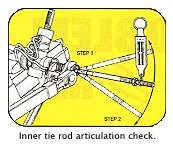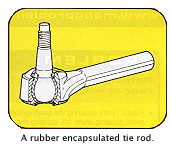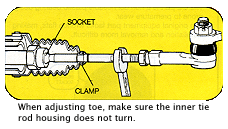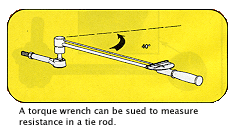Most of us take steering systems for granted because the mechanical connections between the steering wheel and tires on most vehicles seem to be fail-safe and trouble-free for the life of the vehicle. Nevertheless, an occasional steering system adjustment or component replacement may be needed to correct damage or wear incurred in day-to-day use. Consequently, in order to better capitalize on the steering system market, an undercar shop should be performing a steering system inspection at every scheduled maintenance interval.
Today’s Steering Systems
A modern steering system not only points the vehicle in the right direction, but also determines the safety, comfort, performance and fuel economy of the vehicle.
From the steering angle, it’s obvious that if the vehicle doesn’t respond well to steering wheel input from the driver, the vehicle is essentially out of control. From the comfort angle, it becomes a very tiring experience if the driver must constantly steer the vehicle to keep it on the road. As for performance, modern steering should be crisp, responsive and have a refined touch.
Last, fuel economy is directly affected by rolling friction. During the past decade, rolling friction has been greatly reduced in all vehicles by improving lubricants, bearings, powertrains, tires and steering systems. When the steering alignment is several degrees out of specification on toe angle, it will likely reduce fuel economy by at least several miles per gallon on the average late-model vehicle.
Rack It Up
Let’s look at how modern steering systems are designed. First, the rack-and-pinion steering gear, or “rack” as it’s more commonly known, has replaced the steering gear on the majority of import chassis designs because it’s lighter, has less moving parts, is more responsive, is more durable, and lends itself well to fundamental design changes like the incorporation of electronically assisted steering.
 A steering gear system contains the steering wheel, steering shaft, U-joints, drag link, idler arm, connecting link, tie rods, and inner and outer tie rod ends. A rack system, on the other hand, contains only the steering wheel, steering shaft, shaft universal joints, tie rods, and the inner and outer tie rod ends. When comparing the number of parts, it’s easy to see why the rack system has become more popular.
A steering gear system contains the steering wheel, steering shaft, U-joints, drag link, idler arm, connecting link, tie rods, and inner and outer tie rod ends. A rack system, on the other hand, contains only the steering wheel, steering shaft, shaft universal joints, tie rods, and the inner and outer tie rod ends. When comparing the number of parts, it’s easy to see why the rack system has become more popular.
Why are steering gear systems still used? In some applications, such as trucks, for example, a front-mounted steering rack would be very vulnerable to off-road damage. A rear-mounted rack, on the other hand, won’t easily fit in a rear-wheel-drive chassis.
Diagnosing Damaged Steering Systems
How does one know when steering systems are worn, damaged or maladjusted? The first indications are usually steering pull or wandering complaints. Although steering pull can usually be attributed to side-to-side differences in caster and camber, an occasional steering pull can be caused by an “off-center” steering gear or rack that is not aligned with the thrust line of the vehicle.
 In order to provide better steering feel, steering gears and racks are designed to operate with nearly zero gear lash in the straight-ahead position. As a result, the driver can “feel” the steering gear return to a straight-ahead position when completing a turn. Of course, when the steering gear is off-center, the feedback through the steering wheel mimics a pulling condition, with the gear lash tightening up in one direction and loosening in the straight-ahead position.
In order to provide better steering feel, steering gears and racks are designed to operate with nearly zero gear lash in the straight-ahead position. As a result, the driver can “feel” the steering gear return to a straight-ahead position when completing a turn. Of course, when the steering gear is off-center, the feedback through the steering wheel mimics a pulling condition, with the gear lash tightening up in one direction and loosening in the straight-ahead position.
Generally speaking, a steering gear is correctly centered when the steering wheel spokes are horizontal and the pitman and idler arms are in parallel alignment with the frame or center thrust line of the vehicle. A rack, on the other hand, is correctly centered when it’s at the center of its range of travel and the steering wheel is correctly indexed to the steering shaft and rack and pinion gear.
Another issue associated with an off-centered steering gear is unequal side-to-side turning radius. When steering gears and racks aren’t aligned correctly with the thrust line, the side-to-side turning radii of the wheels become unequal, and the driver develops the uncomfortable feeling that the vehicle isn’t cornering as well as it should.
 Unlike steering pull, steering wander is symptomatic of incorrect toe angle or excessive linkage wear. Although steering linkage geometry is a little too complex to cover in this space, it is safe to say that linkage pivot points and mounting angles should parallel or track with control arm pivots and angles. If linkage travel doesn’t match control arm travel, the toe angle radically changes in direct proportion to the range of suspension travel, which creates a condition known as “bump steer.”
Unlike steering pull, steering wander is symptomatic of incorrect toe angle or excessive linkage wear. Although steering linkage geometry is a little too complex to cover in this space, it is safe to say that linkage pivot points and mounting angles should parallel or track with control arm pivots and angles. If linkage travel doesn’t match control arm travel, the toe angle radically changes in direct proportion to the range of suspension travel, which creates a condition known as “bump steer.”
Wear to Check
Wear in the steering linkage will obviously create a loss of steering response at the steering wheel. Two schools of thought are represented by two different methods of checking wear in steering linkage. The first method of checking wear is the “dry-park” test, in which an assistant turns the steering wheel while the technician checks for looseness in the rack, steering gear, pitman arm, idler arm and tie rod ends. The dry park test is accurate in the sense that the linkage is tested at normal suspension height.
Of course, many alignment techs don’t have assistants, so they raise the vehicle on the alignment machine and proceed to check for wear either by shaking the wheels on a horizontal plane or by prying on the steering linkage or squeezing the tie rod ends with a pair of water pump pliers. Some experts aren’t comfortable with this method because they feel that some wear or play in linkage is acceptable and that the linkage is being tested outside its normal range of travel.
 In the absence of specifications and, especially on import vehicles, it’s my own opinion that there shouldn’t be noticeable play in any steering linkage component. To better explain, a slight amount of wear in each tie rod end and observable vertical play in an idler arm adds up enough to cause a significant change in toe angle, especially when driving on the highly cambered roads found in many northern states. Of course, it’s also important to temper subjective judgments by using available manufacturer’s specifications as a final authority before making any service recommendations to the customer.
In the absence of specifications and, especially on import vehicles, it’s my own opinion that there shouldn’t be noticeable play in any steering linkage component. To better explain, a slight amount of wear in each tie rod end and observable vertical play in an idler arm adds up enough to cause a significant change in toe angle, especially when driving on the highly cambered roads found in many northern states. Of course, it’s also important to temper subjective judgments by using available manufacturer’s specifications as a final authority before making any service recommendations to the customer.
Steering as a Safety System
Because sound steering linkage is a vital safety component of any vehicle, it’s important to inspect linkage for bends, nicks, straightening or other modifications, and shimming to remove excessive play. When linkage is bent, the drag link or tie rod not only loses its operating geometry, it also begins to flex and becomes subject to metal fatigue. In any case, aligning a vehicle with known defects in the steering linkage creates a serious liability issue, especially if the linkage eventually fails and causes accident or injury to the driver and his passengers.











